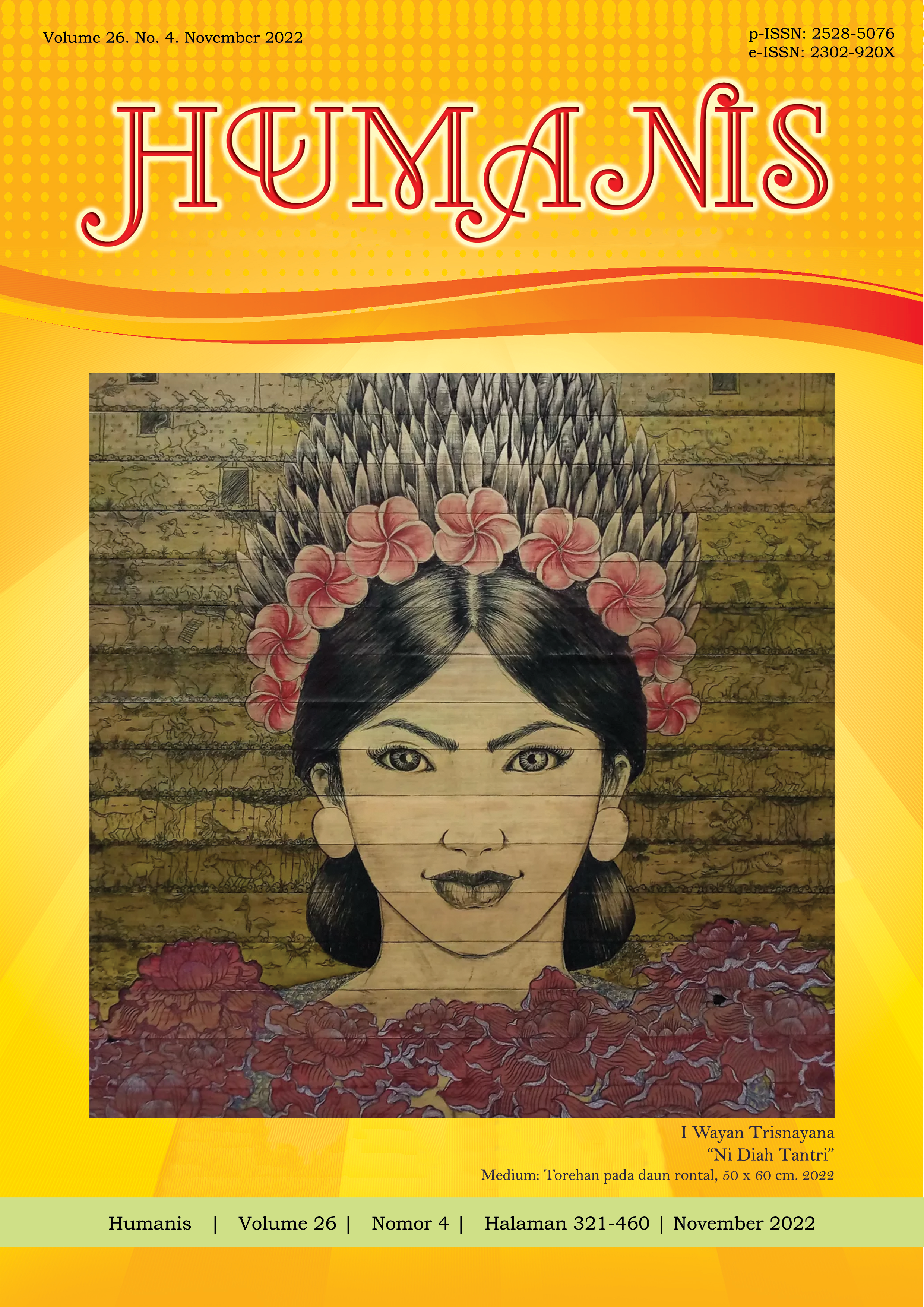Code-Mixing in Alternate Universe Story “Tjokorda Manggala” written by @guratkasih on Twitter
Abstract
This research dealt with code-mixing phenomenon in the AU (alternate universe), that refers to fan fiction about one’s favorite celebrity. This type of fan fiction is mostly and largely published on Twitter as a social media platform. "Tjokorda Manggala," authored by @guratkasih, is one of several AUs with code-mixing in every tweet. This study delves deeper into the many sorts of code-mixing employed in "Tjokorda Manggala." It has been shown that 44 code-mixing occurrences were discovered from 28 tweets, with the kind of insertion (75%) being the highest or most usually employed. Alternation (9.1%) is only utilized in a few circumstances, while congruent lexicalization (15.9%) occurred more frequently than alternation. Some factors that caused code-mixing in the AU are settings and situations, participants, topics, and function of interaction. It is intended that through doing this research, the shift in linguistic patterns and how English has impacted Indonesians may be noticed, even in the realm of fan fiction.
Downloads
References
Akram, W., Department of Computer Applications, GDC Mendhar, Poonch, India, Kumar, R., & Department of Computer Applications, GDC Mendhar, Poonch, India. (2017). A Study on positive and negative effects of social media on society. International Journal of Computer Sciences and Engineering, 5(10), 351–354. https://doi.org/10.26438/ijcse/v5i10.351354
Bhatia, T. K., & Ritchie, W. C. (2013). The Handbook of Bilingualism and Multilingualism 2nd edition. (2nd ed.). Blackwell Publishing.
Cardenas-Claros, M. S., & Isharyanti, N. (2009). Code-switching and code-mixing in Internet chatting: Between “yes”, “ya”, and ’si’-a case study. The JALT CALL Journal, 5(3), 67–78. https://doi.org/10.29140/jaltcall.v5n3.87
Caro, L. (2021, August 6). Alternate universe: Twitter as a platform for new-age literary pieces. POP! https://pop.inquirer.net/113885/alternate-universe-twitter-as-a-platform-for-new-age-literary-pieces#:~:text=AU%20is%20an%20acronym%20for,different%20from%20reality%20or%20canon.
Chen, S., Geluykens, R., & Choi, C. J. (2006). The importance of language in global teams: A linguistic perspective. Management International Review, 46(6), 679–696. https://doi.org/10.1007/s11575-006-0122-6
Dzakiyyah Rusydah. (2020). Bahasa anak JakSel: S sociolinguistics phenomena. LITERA KULTURA : Journal of Literary and Cultural Studies, 8(1). https://doi.org/10.26740/lk.v8i1.33880
Frey, B. B. (2018). The SAGE Encyclopedia of Educational Research, Measurement, and Evaluation. https://doi.org/10.4135/9781506326139
Grosjean, F. (1984). Life with Two Languages (An Introduction to Bilingualism). Harvard University Press.
Halsband, U. (2006). Bilingual and multilingual language processing. Journal of Physiology-Paris, 99(4–6), 355–369. https://doi.org/10.1016/j.jphysparis.2006.03.016
Jimmi, J., & Davistasya, R. E. (2019). Code-mixing in the language style of south Jakarta community Indonesia. Premise: Journal of English Education, 8(2), 193. https://doi.org/10.24127/pj.v8i2.2219
Kirsch, C. (2012). Ideologies, struggles and contradictions: An account of mothers raising their children bilingually in Luxembourgish and English in Great Britain. International Journal of Bilingual Education and Bilingualism, 15, 95–112. https://doi.org/10.1080/13670050.2011.607229
Kopeliovich, S. (2010). Family Language Policy: A Case Study of a Russian-Hebrew Bilingual Family: Toward a Theoretical Framework. Diaspora, Indigenous, and Minority Education, 4, 162–178. https://doi.org/10.1080/15595692.2010.490731
Meigasuri, Z., & Soethama, P. L. (2020). Indonesian–English code-mixing in novel Touché by Windhy Puspitadewi. Humanis, 24(2), 135. https://doi.org/10.24843/JH.2020.v24.i02.p04
Muslimin, A. I. (2020). Code-mixing of Javanese language and bahasa Indonesia in the friday prayer sermon at Miftahul Hidayah osque, Pendem village, city of Batu, East Java. MABASAN, 14(2), 277–296. https://doi.org/10.26499/mab.v14i2.400
Muysken, P. (2000). Bilingual speech a typology of code-mixing. Cambridge University Press.
Myers-Scotton, C. (1993). Duelling languages: Grammatical structure in codeswitching. Clarendon Press.
Namba, K. (2004). An overview of Myers-Scotton’s matrix language frame model. 10.
Park, S. (2019, March 23). Twitter CEO talks about K-Pop’s affect on Twitter and meets with GOT7’s BamBam, Youngjae, and Mark. Soompi. https://www.soompi.com/article/1312094wpp/twitter-ceo-talks-about-k-pops-effect-on-twitter-and-meets-with-got7s-bambam-youngjae-and-mark
Peñalosa, F. (1985). A world-system perspective for Chicano sociolinguistics. International Journal of the Sociology of Language, 53(53), 7–20. https://doi.org/10.1515/ijsl.1985.53.7
Pfaff, C. W. (1979). Constraints on Language Mixing: Intrasentential Code-Switching and Borrowing in Spanish/English. Language (Baltimore), 55(2), 291–318. https://doi.org/10.2307/412586
Poplack, S. (1980). Sometimes I’ll start a sentence in Spanish y termino en Espanol: Toward a Typology of Code Switching. Linguistics, 18, 581–618.
Saddhono, K., & Rohmadi, M. (2014). A Sociolinguistics Study on the Use of the Javanese Language in the Learning Process in Primary Schools in Surakarta, Central Java, Indonesia. International Education Studies, 7(6), p25. https://doi.org/10.5539/ies.v7n6p25
Sudaryanto. (1993). Metode dan Aneka Teknik Analisis Bahasa (Pengantar Penelitian Wahana Kebudayaan Secara Linguistis). Duta Wacana University Press.
Suryadinata, L., Arifin, E., & Ananta, A. (2003). Indonesia’s population: Ethnicity and religion in a changing political landscape. In Indonesia’s Population. https://doi.org/10.1355/9789812305268
Sutrisno, B., & Ariesta, Y. (2019). Beyond the use of code mixing by social media influencers in Instagram. Advances in Language and Literary Studies, 10(6), 143. https://doi.org/10.7575/aiac.alls.v.10n.6p.143
Tanu, D. (2016). Unpacking ‘Third Culture Kids’: The transnational lives of young people at an international school in Indonesia. Journal of Research in International Education, 15(3), 275–276. https://doi.org/10.1177/1475240916669081
Tony, C. (2016, December 29). How stan Twitter is turning Into a community of bullies. Affinity. http://affinitymagazine.us/2016/12/29/how-stan-twitter-is-turning-into-a-community-of-bullies/
Utami, N. M. V., Hakim, D., & Adiputra, I. N. P. (2019). Code Switching Analysis in the Notes Made by the Sales Assisstants in Ripcurl. Lingual: Journal of Language and Culture, 6(2), 20. https://doi.org/10.24843/LJLC.2018.v06.i02.p04
Wardhaugh, R. (2006). An introduction to sociolinguistics (5th ed.). Blackwell Pub.
Yulianti, E., Kurnia, A., Adriani, M., & Duto, Y. S. (2021). Normalisation of Indonesian-English code-mixed text and its effect on emotion classification. International Journal of Advanced Computer Science and Applications, 12(11). https://doi.org/10.14569/IJACSA.2021.0121177


















